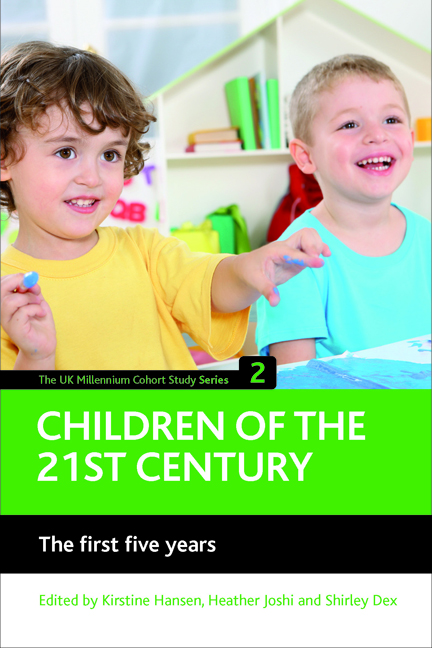Book contents
- Frontmatter
- Contents
- Acknowledgements
- List of contributors
- Glossary
- one Introduction
- two Child poverty in the first five years of life
- three Ethnicity, community and social capital
- four Parental relationships and parenting
- five Partnership trajectories, parent and child well-being
- six Employment trajectories and ethnic diversity
- seven Neighbourhoods and residential mobility
- eight Childcare in the pre-school years
- nine Intergenerational inequality in Early Years assessments
- ten Ethnic inequalities in child outcomes
- eleven School choice
- twelve Teacher assessments in the first year of school
- thirteen Childhood overweight and obesity
- fourteen Resilience in children's development
- fifteen Parental and child health
- sixteen Conclusions
- References
seven - Neighbourhoods and residential mobility
Published online by Cambridge University Press: 01 September 2022
- Frontmatter
- Contents
- Acknowledgements
- List of contributors
- Glossary
- one Introduction
- two Child poverty in the first five years of life
- three Ethnicity, community and social capital
- four Parental relationships and parenting
- five Partnership trajectories, parent and child well-being
- six Employment trajectories and ethnic diversity
- seven Neighbourhoods and residential mobility
- eight Childcare in the pre-school years
- nine Intergenerational inequality in Early Years assessments
- ten Ethnic inequalities in child outcomes
- eleven School choice
- twelve Teacher assessments in the first year of school
- thirteen Childhood overweight and obesity
- fourteen Resilience in children's development
- fifteen Parental and child health
- sixteen Conclusions
- References
Summary
Introduction
In the Millennium Cohort Study (MCS) children's early years, many families had not settled permanently in the home and place in which they would spend most of their childhood. Nearly half had moved home at least once between the interviews at 9 months and age 5. This chapter is concerned with the families’ satisfaction with the area they were living in at age 5 and the moves that had been made to get there, from diverse social and spatial starting points.
It is relatively common for families with young children to move home (Plewis et al, 2008). Such mobility often benefits both adults and children, for example when it is related to changes of job. The unemployed may move to improve their employment prospects (Boheim and Taylor, 2002). Residential mobility may be motivated by consideration of school choice, with families relocating close to ‘good’ schools (Gibbons and Machin, 2006). After a(nother) child is born, some families will move to larger/better accommodation or to a better/safer area. Others move in less favourable circumstances, for example, because they have been evicted, or because a couple splits up. Whatever the circumstances, moving home, and possibly moving job or school as well, can be very stressful for both adults and children. Moving can result in the loss of a supportive social network of friends and neighbours and this loosening of the ‘ties that bind’, as discussed in Chapter 3 (this volume), may have untoward consequences. Frequently moving couples have been found to have a high risk of union break up (Boyle et al, 2008).
Is there evidence that moving home disrupts children's lives? Cullis (2008) found no difference in cognitive and behavioural scores of MCS children at age 3 according to whether the families had moved home between the first two surveys. Verropoulou et al (2002) examined the relationship between moving home, family structure and children's well-being, using data collected on the schoolaged children of one third of the British 1958 cohort members (National Child Development Study, NCDS). They found little to no association between moving residence and children's well-being measured by attainment in mathematics and reading and on assessments of aggression and anxiety.
- Type
- Chapter
- Information
- Children of the 21st century (Volume 2)The First Five Years, pp. 115 - 130Publisher: Bristol University PressPrint publication year: 2010



